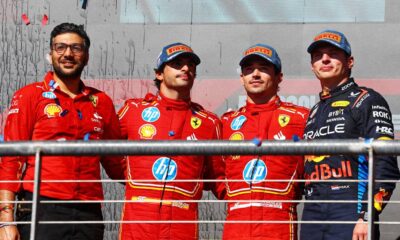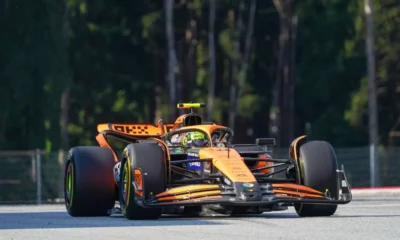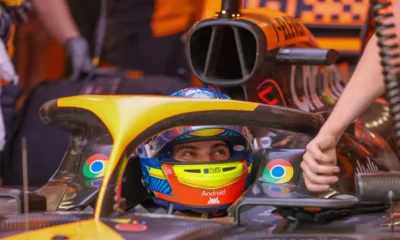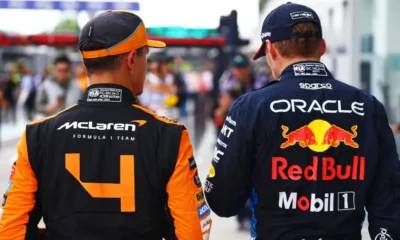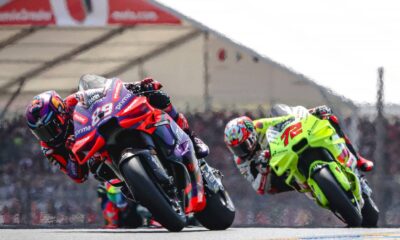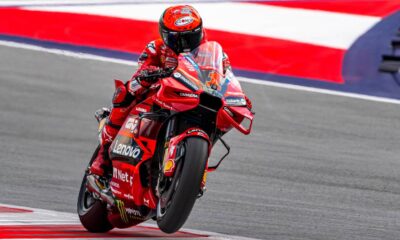Motorsport
Ferrari’s disastrous strategy, Binotto’s reprehensible statement, a victory with a bitter taste: what did the Italian team do to upset its fans?
Comment: the British Grand Prix was the tenth event of this season. And it was probably the best race of the year, but not for Ferrari fans. At least for many of them. The Italian team’s planning at Silverstone was absolutely tragic, with team boss Mattia Binotto putting the finishing touches to it all.
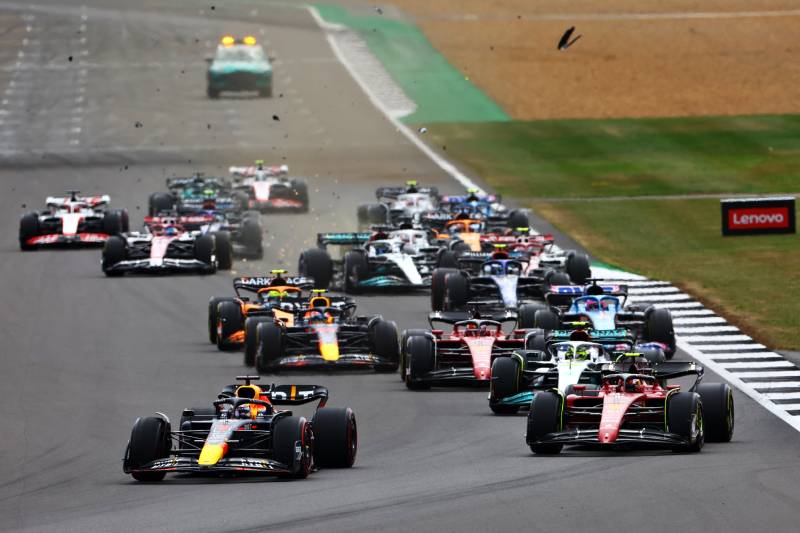
Comment: The British Grand Prix was the tenth event of this season. And it was arguably the best race of the year, but not for Ferrari fans. At least for many of them. The Italian team’s planning at Silverstone was absolutely tragic, with team boss Mattia Binotto putting the finishing touches to it all.
It was not only the best race of this season, but also one of the best events in F1 history. Objectively, the British Grand Prix can be described as an advertisement for motorsport. There were beautiful duels and overtaking manoeuvres, dramatic moments and what is an integral part of motorsport – a dangerous crash.
Fortunately, Kuan-yu Zhou escaped without any serious injuries and the first moments after the crash were stressful not only for many fans due to concerns about the health of the young Chinese pilot.
If we subject the British Grand Prix to our classic nitty-gritty, we find that this race once again showed us a lot. And this is mainly from the perspective of Ferrari, who are currently being massively pilloried by their own fans on social media.
Carlos Sainz scored the win, but…
The first triumph of the 27-year-old Spaniard’s F1 career. Sainz has been waiting for the moment that all Formula One drivers crave, and that is to win a race, since 2015, specifically 150 Grands Prix. The British Grand Prix didn’t go well for Sainz at first, when Max Verstappen pulled ahead of him on his first start thanks to a better ‘tee-off’.
After a few moments, however, red flags flew on the circuit and race directors decided to suspend the British Grand Prix due to a huge collision involving Chou and other hard contacts.
After a one-hour break, the FIA announced a restart from fixed positions in the order that corresponded to the original start. And on this second attempt, Sainz held on to his first place. But the Spanish driver lost that on lap 10 when he made a minor driving error in the Maggot and Becketts corner section and went off the track.
Verstappen duly took advantage of this to take the lead. However, the order at the front changed again, two laps later.
Verstappen began to lose a lot of speed, which Sainz took advantage of and retook the lead of the British Grand Prix on the Hangar Straight. The race engineer then told Verstappen over the team radio that his Red Bull had some sort of aerodynamic problem and thus could not go full throttle due to a worse aero on the left side of the car.
The reigning world champion explained after the race that the loss of power (Verstappen had problems with downforce even in slow corners and suffered from understeer – ed.) was caused by a damaged floor.
This is a piece of debris from the AlphaTauri monoposto that got stuck in the floor and damaged it.
Ferrari’s strategy, did the Italian team lose the double?
So from this point on, it was both Ferraris in the lead – Sainz first, Charles Leclerc second, with Leclerc being the quicker of the pair, despite the damage to his front wing after his duel with Pérez.
So not only was Sainz slowing down his teammate, but third-placed Hamilton was faster and faster on every lap. According to F1 livetiming, Hamilton was beating Sainz’s times by two, three and four tenths of a second in succession. On lap 16, the seven-time world champion was half a second quicker.
In retrospect, however, this situation was not as crucial for Ferrari as the moments that followed. Yes, Leclerc had the pace to pull away from Sainz and Hamilton to within a few seconds of each other, creating a comfortable lead. Again, this was a factor that would make the Italian team’s decision-making easier later in the race with regard to pit stops.
Ferrari eventually called Sainz into the pits first, dropping him to third. It should be noted, on that 21st lap, Hamilton had only 2.5 seconds on leader Leclerc. The Ferrari driver went to his mechanics at the end of the 25th lap, when his lead over second-placed Hamilton was only eight tenths of a second.
Time lost, although this was not yet so critical.
Hamilton leads the grand prix for the first time this season
After stops by both Ferrari drivers, Hamilton, who was leading the race for the first time this year, took the lead. And it was then that the Italian stable made a strange strategic decision. Leclerc dropped to third place behind Sainz after his stop
But Leclerc’s pace was faster again, instead of the classic team override, where the team instructs the drivers to swap positions, Ferrari let both their drivers race. Although Leclerc was faster than both Hamilton and his teammate.
Ferrari only realised this on lap 31 when Sainz let Leclerc go ahead. After about four laps, the Monegasque had built up a two-second lead on Sainz. The thought of how secure a lead Leclerc could have built up with an ideal team strategy probably makes Ferrari fans jump out of their seats. More time lost.
Hamilton pitted on lap 34, dropping him back to third. But he was only 2.2 seconds behind second-placed Sainz on the exit of pit lane. Fortunately for Ferrari, by the time Hamilton managed to warm up the hardest tyre compound, that gap had grown to 4.2 seconds.
Here we have to give Hamilton’s tyre work some objective credit, as he pulled off a solid stint. By this time he had 13 laps fresher tyres than Sainz, 8 than Leclerc.
By the end of lap 38, leader Leclerc had built up a four-second lead on Sainz, who in turn was closing the gap on third-placed Hamilton (by this time it was down to just two seconds). On lap thirty-nine, when Esteban Ocon abandoned his Alpine on the Hangar Straight and the race directors called the safety car onto the track, Hamilton cut Sainz’s lead to 1.4 seconds. Leclerc extended his lead on his stablemate by a further 7 tenths of a second.
The massive criticism of Ferrari, not only from the experts, but also from their fans
And here comes the most crucial mistake of the whole race. From the point of view of Ferrari and its fans, of course. The Italian team had about nine seconds to tell Leclerc over the team radio that he had to go to his mechanics to change to the softest and fastest tyre specification.
But it seems Ferrari’s hesitation knows no bounds. So the team has left Leclerc on the track with worn hard tyres that are nowhere near as grippy as the softest set. At a press conference later, team boss Mattia Binotto said that Leclerc was left on the track because of “track position”, or the fear that Leclerc would lose the win.
This argument, however, angered many Ferrari fans and was also wondered about by many experts. Including Sky Sports commentators. But a worse statement from Binotto came later when the fifty-two year old Italian said that Ferrari “are not fighting for the title, they are fighting to be competitive.”
This is something that experts have been predicting since before the season and often during the season itself. The political side and decision-making processes – this is a big weakness of Ferrari at the moment. So why is the argument that Ferrari was worried about track position undesirable?
Leclerc had a 9 second lead on second placed Sainz and a roughly 11 second lead on third placed Hamilton during the safety car. There are three levels to this affair. The first is that drivers in a safety car activated state have to maintain a set speed. Thus, the amount of time you have to get on the next driver to make the necessary pit-stop is greatly reduced.
Secondly, Ferrari had plenty of room for a double pit-stop thanks to Leclerc’s lead over second-placed Sainz. After all, Sainz pitted with Hamilton and held on to his second place after the stop. But what would have happened, you wonder, if Hamilton had stayed on the track and taken the top spot thanks to both Ferrari drivers’ stops?
Simply probably nothing, as we saw the hardest worn tyres working on Leclerc’s car after the restart. In short, Mercedes would have gained nothing by leaving Hamilton on track as all the drivers behind him, including Sergio Pérez, Fernando Alonso and Lando Norris, were wearing the fastest tyre compound.
It would therefore be a matter of time before Hamilton would be passed by both Ferrari drivers, whose cars were performing superbly on the red fastest set, and Pérez as well, and it is questionable whether Hamilton would fall behind Alonso or Norris as well.
The seven-time world champion simply had to stop too if he wanted to target the podium at his home grand prix. And in the event of a Ferrari double pit-stop, the Italian team would remain in the top two places.
The restart of the British Grand Prix
So, before the restart on lap 43, the order of the top six was: Leclerc, Sainz, Hamilton, Pérez, Alonso, Norris. All but Leclerc made a pit stop to change to a red set of tyres.
Before the restart, Ferrari made another strange decision. The race engineer told Sainz on the team radio to use his second place to create a ten car length space for Leclerc, even though he was wearing the fastest specification tyres.
This decision by Ferrari contrasted strongly with what had happened earlier, when they had left Leclerc on track on the white hardest set of tyres. An instruction that went against racing logic. And it didn’t go down well with Sainz, the 27-year-old Spanish driver refusing to act as a “human shield”.
To the eye of the beholder, the last ten laps were truly spectacular. Sainz first got ahead of his teammate on the restart thanks to a fresh set of tyres. Leclerc fought fiercely with Hamilton and Pérez on the hard set, even though he was doomed to lose.
This dropped the Ferrari driver to fourth with four laps to go and he had to withstand heavy pressure from fifth-placed Alonso and sixth-placed Norris. However, thanks to a great defensive performance, he at least held on to fourth place. The lead remained unchanged for the next three laps.
Sainz celebrated his first career victory, with Pérez and Hamilton rounding out the podium. In terms of the title fight, however, this Ferrari simply didn’t get it right strategically. Leclerc, despite the promising development of the British Grand Prix, drove to 12 points in the drivers’ championship, with Pérez again second in the overall standings.
Considering the Constructors’ Cup, Red Bull has done a very decent damage limitation, with a still solid 63-point lead over second-placed Ferrari. Moreover, immediately after the race, Binotto strongly reminded an already frustrated Leclerc what to say and what not to say in the subsequent interviews.
Leclerc’s reaction
“I was at my limit, I was trying to do my best on the used tyres and I was constantly checking Lewis behind me, trying to take advantage of every apex. I kept telling myself it was realistic to keep the podium. Even though I knew it was going to be very difficult, I believed until the last lap,” Leclerc told Motorsport.
Leclerc then stressed that despite his frustration he was happy that Sainz had achieved his first victory. Objectively, however, it can be noted that his feelings are in no way surprising. Ferrari made decisions during the British Grand Prix that caused the exact opposite of what Leclerc needed from his team.
And Ferrari fans shouldn’t be surprised either. Yes, Sainz has finally stood on that top step of the podium. But at the cost of a very likely double and a significant points reduction on the Red Bull drivers in both the Drivers’ and Constructors’ Cup championships. A victory with a bitter taste.
Sources

-
Motorsport4 days ago
Jorge Martín is rewriting history! the 26-year-old Spaniard became the new MotoGP World Champion, Bagnaia succumbed despite his best efforts
-
Motorsport5 days ago
Bagnaia keeps hopes of a miracle alive with MotoGP sprint win in Barcelona, third-placed Martín one step away from title
